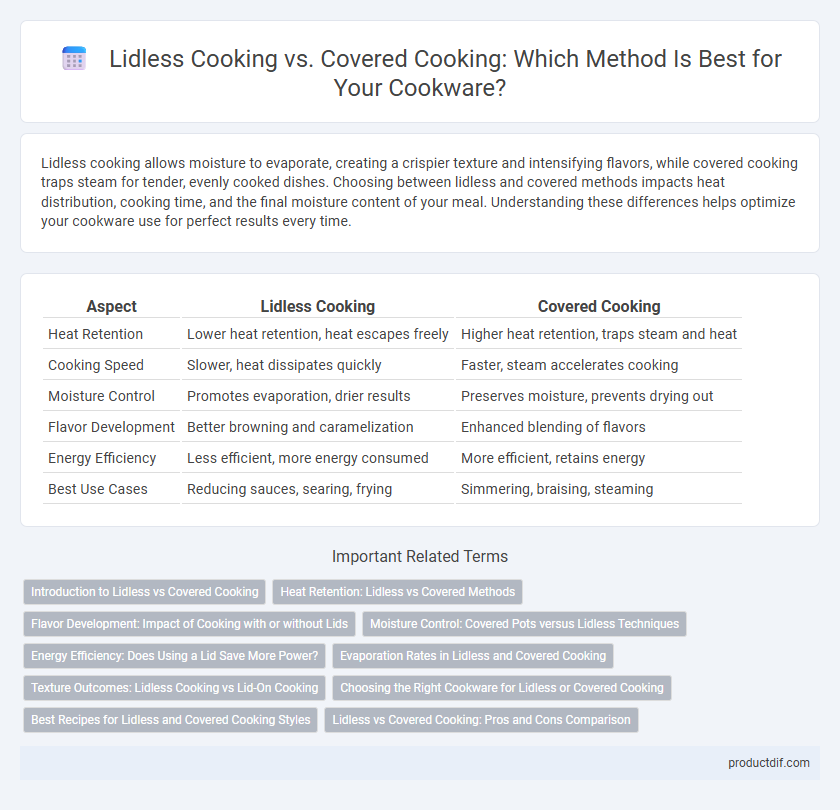Lidless cooking allows moisture to evaporate, creating a crispier texture and intensifying flavors, while covered cooking traps steam for tender, evenly cooked dishes. Choosing between lidless and covered methods impacts heat distribution, cooking time, and the final moisture content of your meal. Understanding these differences helps optimize your cookware use for perfect results every time.
Table of Comparison
| Aspect | Lidless Cooking | Covered Cooking |
|---|---|---|
| Heat Retention | Lower heat retention, heat escapes freely | Higher heat retention, traps steam and heat |
| Cooking Speed | Slower, heat dissipates quickly | Faster, steam accelerates cooking |
| Moisture Control | Promotes evaporation, drier results | Preserves moisture, prevents drying out |
| Flavor Development | Better browning and caramelization | Enhanced blending of flavors |
| Energy Efficiency | Less efficient, more energy consumed | More efficient, retains energy |
| Best Use Cases | Reducing sauces, searing, frying | Simmering, braising, steaming |
Introduction to Lidless vs Covered Cooking
Lidless cooking allows moisture to evaporate, intensifying flavors and achieving desired reductions in sauces or soups. Covered cooking traps heat and steam, promoting even cooking and retaining moisture for tender results. Choosing between lidless and covered methods depends on the specific recipe and desired texture.
Heat Retention: Lidless vs Covered Methods
Covered cooking enhances heat retention by trapping steam and maintaining a stable temperature, which speeds up cooking and conserves energy. Lidless cooking allows heat and moisture to escape, resulting in longer cooking times and potential heat loss. The choice between lidless and covered methods significantly affects heat efficiency and dish texture, with covered cooking preferred for simmering and steaming.
Flavor Development: Impact of Cooking with or without Lids
Cooking with lids traps steam and moisture, intensifying flavors by promoting even heat distribution and preventing evaporation of aromatic compounds. Conversely, lidless cooking allows moisture to escape, concentrating flavors through caramelization and browning, which enhances the Maillard reaction. Choosing between lidless and covered cookware affects the texture, aroma, and depth of flavor in dishes like stews, braises, and pan-seared meats.
Moisture Control: Covered Pots versus Lidless Techniques
Covered pots trap steam, maintaining moisture and preventing food from drying out during cooking, which is essential for tender meats and delicate sauces. Lidless techniques allow moisture to evaporate, intensifying flavors through reduction and crisping textures by promoting evaporation. Choosing between lidless and covered cooking directly impacts moisture levels and dish outcomes, with covered pots preserving juiciness and lidless methods enhancing concentration and texture.
Energy Efficiency: Does Using a Lid Save More Power?
Cooking with a lid significantly enhances energy efficiency by trapping heat and moisture, which reduces cooking time and lowers fuel consumption. Lidless cooking allows steam to escape, leading to heat loss and increased energy use to maintain the desired temperature. Studies show that covering pots can save up to 30% more energy compared to cooking without a lid.
Evaporation Rates in Lidless and Covered Cooking
Lidless cooking significantly increases evaporation rates by allowing moisture and steam to escape freely, which concentrates flavors but reduces liquid volume faster. Covered cooking traps steam, reducing evaporation rates and maintaining moisture levels, essential for slow-simmered dishes and sauces. Understanding evaporation differences helps optimize cooking methods for desired texture and flavor outcomes.
Texture Outcomes: Lidless Cooking vs Lid-On Cooking
Lidless cooking promotes evaporation, resulting in concentrated flavors and crispier textures, ideal for reducing sauces and achieving a caramelized finish. Covered cooking traps steam and moisture, producing tender, juicier dishes with softer textures, perfect for braising and simmering. Choosing between lidless and lid-on methods directly impacts the moisture retention and texture development of the food.
Choosing the Right Cookware for Lidless or Covered Cooking
Selecting cookware with or without lids depends on cooking techniques and desired outcomes; lidless cookware promotes evaporation and browning ideal for searing or reducing sauces, while covered cookware retains moisture and heat, perfect for simmering or steaming. Materials such as stainless steel, cast iron, or nonstick surfaces impact heat distribution and durability, influencing their effectiveness in lidless or covered cooking. Prioritize cookware with well-fitted lids made of heat-resistant glass or stainless steel for covered cooking, and opt for pans with wide, open designs for lidless methods to optimize kitchen efficiency and culinary results.
Best Recipes for Lidless and Covered Cooking Styles
Recipes ideal for lidless cooking include seared steaks, roasted vegetables, and fried eggs, where moisture evaporation and crust formation enhance flavor and texture. Covered cooking excels with braised dishes, simmered soups, and steamed vegetables, as the lid traps steam and heat, promoting even cooking and moisture retention. Choosing the appropriate cooking style optimizes recipe outcomes by balancing moisture control and heat distribution.
Lidless vs Covered Cooking: Pros and Cons Comparison
Lidless cooking provides better moisture evaporation and browning, enhancing flavor development and preventing sogginess, but it requires more attention to avoid drying out food. Covered cooking retains heat and moisture, reducing cooking time and preserving nutrients, yet it may cause steaming that leads to softer textures and potential overcooking. Choosing between lidless and covered cooking depends on the desired texture, cooking speed, and moisture retention for specific recipes.
Lidless Cooking vs Covered Cooking Infographic

 productdif.com
productdif.com